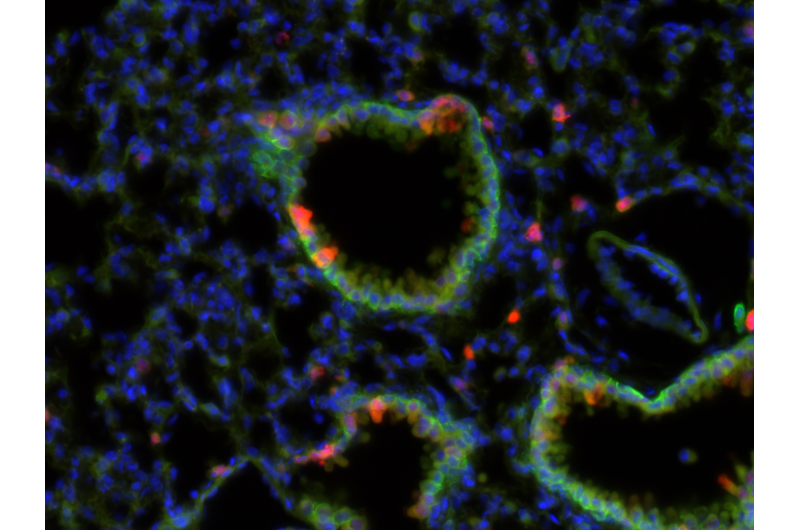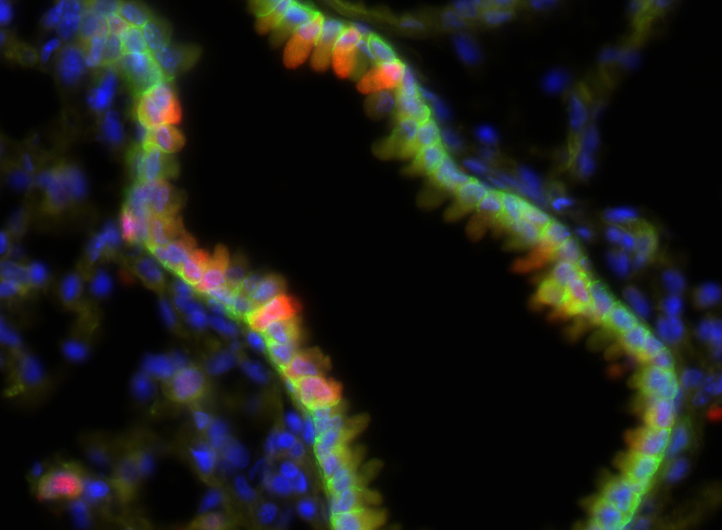Ancient enzyme protects lungs from common irritant produced by bugs and mold

The beetle's tough shell and the crab's sturdy armor both owe their strength to a compound called chitin (pronounced "KAI-tin"), one of the toughest known natural materials and also one of most common biological compounds on Earth. New research in mice by UC San Francisco scientists shows that the lungs secrete a specialized enzyme capable of destroying chitin, without which chitin particles inhaled from the environment can accumulate in the airways and trigger inflammatory lung disease.
Insects, molds and parasitic worms—all common sources of allergies or inflammation—produce billions of tons of chitin a year. Enzymes specialized for breaking down and disposing of chitin, called chitinases, evolved very early in the history of life, and are shared by most living things, from single-celled bacteria and fungi to humans. However, the function of these enzymes in mammals (which don't produce chitin of their own) has long been a mystery to science.
In a new study—published online April 20, 2017, in Cell—researchers in the lab of Richard M. Locksley, MD, the Marion and Herbert Sandler Distinguished Professor in Asthma Research at UCSF, have shown that mice that lack chitin-destroying enzymes soon accumulate chitin in their lungs even in sanitized laboratory environments. These mice go on to develop severe inflammatory lung disease with age, but the team also found that they could dramatically restore lung function in these ailing mice by replacing the missing chitinase enzymes, either genetically or with drugs, a finding that may have implications for understanding and treating age-related lung disease in humans.
"We were very excited to see that improving chitinase activity quickly cleared up the signs of chronic inflammatory lung disease in these mice," said Locksley, who is the senior author of the new study. "To our knowledge this is the first demonstration that chitinases play a key role in preserving lung function in vertebrates."
Study strengthens link between chitin and age-related fibrotic lung disease
Many tissues develop fibrous scar tissue as part of their normal response to injury. These scars typically fade with time, but chronic irritation and inflammation can lead to extensive scarring of organs, known as fibrosis, which our bodies have increasing trouble repairing as we age. Fibrosis is now seen by many researchers as a central underlying risk factor for many diseases of aging, and can eventually lead organs to fail completely. In the case of fibrotic lung disease—which is currently estimated to affect tens of thousands of Americans and appears to be on the rise as the population ages—researchers suspect that a lifetime of environmental exposures trigger chronic inflammation and fibrosis of lung tissue. The resulting tissue damage frequently leads to death within five to 10 years after diagnosis.
Previous research by the Locksley lab had shown that chitin can trigger lung inflammation in mice, and the researchers had suspected that chronic inhalation of chitin particles over a lifetime (through exposure to dust mites or mold, for example) could play an important role in age-related fibrotic lung disease in humans.

In the new study, which was spearheaded by postdoctoral researcher Steven Van Dyken, PhD, researchers showed that specialized cells lining the airways of mice produce a chitinase enzyme called AMCase, which appears to play a key role in preventing chitin buildup in the mouse lung. In mice genetically modified to lack this enzyme, chitin spontaneously built up in the airways and triggered a chronic inflammatory immune response, as well as setting off cellular stress pathways that have previously been linked to lung disease in humans.
Because chitin is so ubiquitous in the environment, the researchers did not have to take any special steps to expose the mice to the compound—even in highly sanitized laboratory settings, Van Dyken said:
"Chitin is a very common, very tough environmental particle found in our homes and workplaces. Our results clearly show that this stuff naturally gets into the lungs, and in the absence of chitinase enzymes that are capable of breaking it down, it accumulates. With time, chitin buildup can make animals pretty sick in ways that look remarkably like human fibrotic lung disease."
Chitin-clearing enzyme could help patients with fibrotic lung disease
The researchers found that young mice were able to tolerate chitin-triggered inflammation without exhibiting signs of lung dysfunction, but as adults these mice experienced rapidly declining health, including many signs of advancing fibrotic lung disease. As a result, mice lacking AMCase died at a dramatically younger age than control mice. However, the researchers also found that the symptoms of lung disease in these mice could be rapidly cleared up by restoring chitinase activity genetically or with drugs.
The team also studied humans with inflammatory lung disease and found elevated levels of chitin in their lungs. They found that humans also produce AMCase, though at considerably lower levels than laboratory mice. The researchers did not find evidence that chitinase activity was any lower than normal in patients with inflammatory lung disease, but they hypothesize a vicious cycle whereby aging-associated lung fibrosis damages the lung's natural ability to use AMCase and possibly other chitinases to clear chitin, allowing increasing chitin buildup to further exacerbate lung inflammation and fibrosis.
The new findings suggest that that enhancing chitinase activity with drugs could be a useful treatment for patients with inflammatory lung disease, the authors said.
"We're excited about potential for using these new insights to help find new treatments for flare-ups or worsening lung disease where people get very sick very quickly," Van Dyken said. "At the moment, there are really no good treatments, so if added doses of chitinase could help or lessen symptoms of fibrotic lung disease, we're really anxious to work towards making such a treatment available."
















